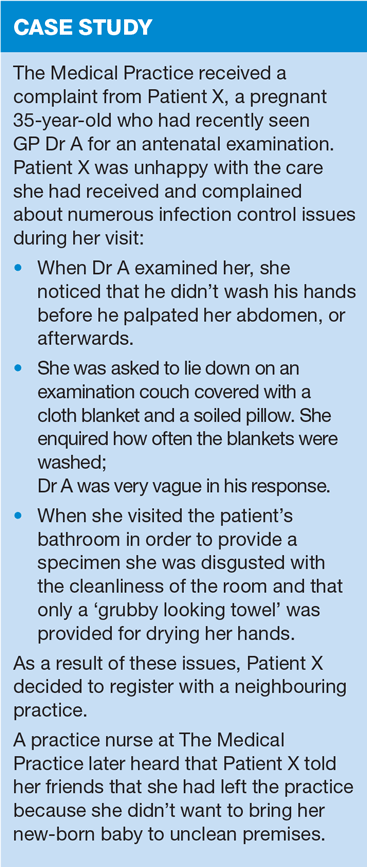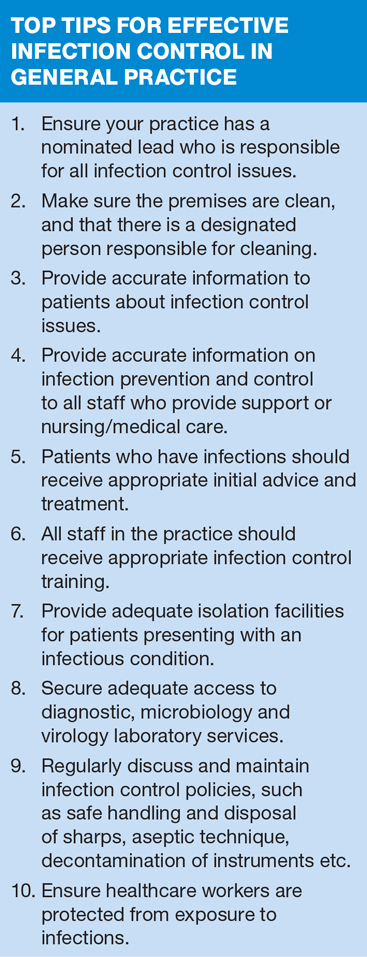Ensuring effective infection prevention and control methods in general practice
Kate Taylor
Kate Taylor
Clinical Risk Education Manager, Medical Protection
Despite a wealth of guidance and information on infection control measures, standards in general practice are often found wanting – and this can lead to complaints or an adverse CQC rating
It is expected that healthcare providers should meet good hygiene standards; however, some practices are still running into difficulties. In 2015, more than one in five (22%) practices inspected by the independent healthcare regulator, the Care Quality commission (CQC), were found to require improvement in relation to infection control.1 This article aims to provide tips for practices to help them provide patient care in a clean and safe environment where the risk of infection to patients and staff is kept to the minimum.
THE EVOLUTION OF INFECTION CONTROL
Infection prevention and control has always been at the heart of the nursing profession and stems back to early influences, such as Florence Nightingale in the days of the Crimean war, where a lack of cleanliness was identified as a key contributing factor of mortality. While the introduction of hand washing and hospital cleanliness in the 1800s was the birth of some of the principles of infection control which remain in healthcare provision today, there have also been many developments and advances which have led to how we now manage infection control in healthcare.
HOW CAN PRACTICES IMPROVE?
In recent years, Medical Protection has conducted over 1000 clinical risk self-assessments (CRSAs) in general practice across the UK and Ireland. CRSAs are a unique programme provided by Medical Protection as a benefit of membership, and are designed to identify potential risks within a practice and develop practical solutions to mitigate these risks, ensure quality of practice, and prevent harm to patients by making the systems in your practice safer.2
The data collected from the results of over 100 CRSAs conducted during 2015 revealed that over three quarters (79.6%) of practices that Medical Protection visited had infection control issues. The following are the problems we identified, and our recommendations.
STAFF IMMUNISATIONS
In 39.8% of practices, GPs had not considered what vaccinations were required for members of staff. The Health and Safety Executive (HSE) has produced guidelines on the legal duties of employers and employees in relation to blood borne viruses such as hepatitis B, stating that ‘decisions about vaccinations recommended should be based on the duties of the individual rather than on job title alone.’3
Recommendation
All clinical and non-clinical staff should be offered vaccinations if a risk assessment reveals that their work may expose them to blood borne virus infection and/or other infectious diseases, such as Hepatitis B or influenza.
SPECIMEN HANDLING
One quarter (25%) of practices visited were found to have risks associated with specimen handling, ranging from obtaining samples that may be contaminated whilst the patient produces bodily fluids, to storing samples.
Recommendation
GPs and practice nurses should issue patients with a labelled specimen container when requesting a specimen, removing the need to decant samples. Reception staff should not touch patient specimens, and samples in inappropriate containers should not be accepted. A box could be provided at the reception desk for patients to leave their samples, which can be passed straight to the nursing staff.
HAND WASHING
Surprisingly, almost a quarter (24.1%) of practices visited had not provided staff with training in hand washing. Effective hand washing prevents the transmission of micro-organisms to yourself and others and is the single most important procedure for infection control.
Recommendation
Teach all healthcare staff how to correctly clean their hands with both alcohol hand gel and soap and water. All staff should also have access to suitable personal protective equipment such as gloves, aprons and eye protection.
TOYS
Waiting room toys were not cleaned routinely in one in five (20.4%) of the practices visited. While soft toys are hard to disinfect and rapidly become re-contaminated after cleaning, hard toys (such as bead frames or activity tables) can easily be disinfected.
Recommendation
It is a good idea to remove all soft toys from the practice and regularly check hard toys as part of the cleaning schedule to ensure they are safe and clean.
STAFF TRAINING
Ensuring that staff have the appropriate knowledge and skills is essential for best practice in infection control and prevention. However, 14% of practices visited experienced issues relating to this.
Recommendation
All staff working in general practice should have appropriate training to ensure they understand and follow the practice’s written policy on all aspects of infection control. This should begin with an induction for all new staff and be maintained through regular updates. Topics should include, but not be limited to: hand washing, management of sharps and clinical waste, and management of spillages of blood and body fluids.
CLEANING OF PREMISES
Of the practices visited in 2015, 6.5% reported risks associated with the cleaning of the premises. These risks related more to the schedule of cleaning for each individual practice rather than the effectiveness or efficiency of those undertaking the housekeeping roles.
Recommendation
Ensure your practice has a regular, planned and monitored cleaning schedule which provides details about how the environment and equipment (for example chairs and examination couches) are to be cleaned, and how frequently. It is important that mops, buckets and cleaning cloths are colour coded to differentiate use between clinical and public areas. Mops should also always be washed and hung to dry after use, should not be left wet in buckets, and should be replaced regularly.
ENSURE YOUR PRACTICE IS COMPLIANT
General practice teams must also ensure that they are compliant with the CQC’s standards, including Outcome 8, Regulation 12 which specifically relates to infection control.1 Alongside this, The Health and Social Care Act 2008: Code of Practice on Prevention and Control of Infection and its Related Guidance (2015) requires general practice teams to produce an annual statement with regard to infection prevention and cleanliness compliance.4
Such a statement should begin with a summary of any action taken in the previous 12 months. It is then important to include comprehensive information on any significant events that have occurred at the practice relating to infection control, for example, needle stick injuries and vaccine refrigerator breakdowns. This should be followed by clear details of any risk assessments and audits related to infection control carried out during the year, including any actions required as a result.
It is also good practice to include the following in an annual infection control statement:
- The practice’s infection prevention and control lead (including their responsibilities and any training they have completed),
- Any infection control training provided to clinical and non-clinical staff (including the cleaner[s]),
- All infection control policies that have been reviewed and/or updated in the previous 12 months, and
- The details of the personnel completing the statement and when it was signed off.
General practice teams may wish to consider publishing this statement on the practice website and on the practice notice board.
DID YOU SEE?
If you missed Sara richard's article, Infection control: taking the lead, you can catch up now. Read more
REFERENCES
1. Care Quality Commission (2010) Essential standards of quality and safety, London, at: http://www.cqc.org.uk/
2. Medical Protection Society Clinical Risk Self Assessments, at: http://www.medicalprotection.org/uk/about-mps/media-centre/media-gallery/videos/videos/clinical-risk-self-assessments-for-gp
3. The Health and Safety Executive (1974)The Health and Safety at Work Act, at: http://www.hse.gov.uk/
4. Department of Health (2015) The Health and Social Care Act 2008: Code of Practice on Prevention and Control of Infection and its Related Guidance, at: https://www.gov.uk/government/publications/the-health-and-social-care-act-2008-code-of-practice-on-the-prevention-and-control-of-infections-and-related-guidance
Related articles
View all Articles

